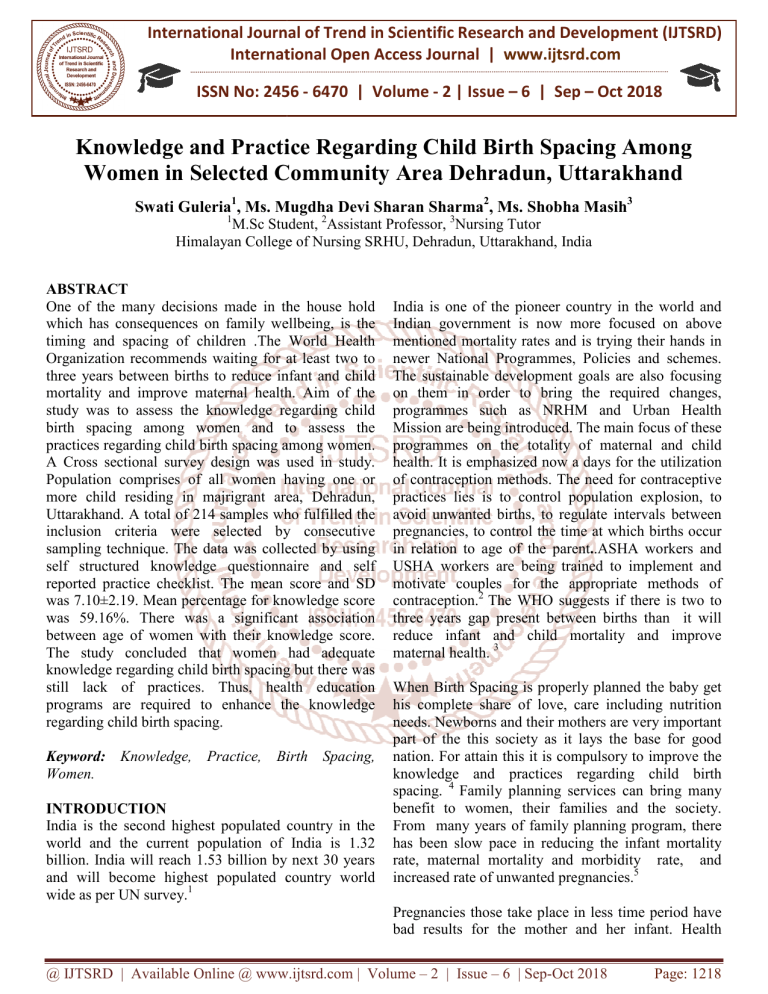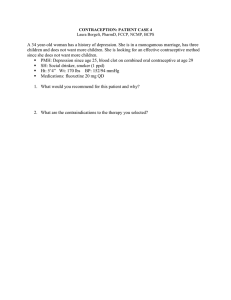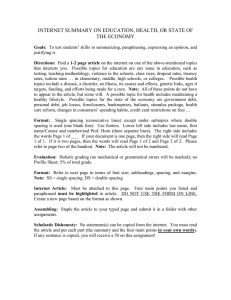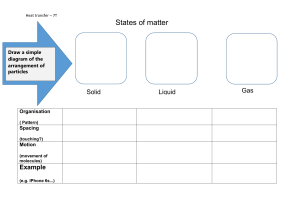
International Journal of Trend in Scientific Research and Development (IJTSRD)
International Open Access Journal | www.ijtsrd.com
ISSN No: 2456 - 6470 | Volume - 2 | Issue – 6 | Sep – Oct 2018
Knowledge and
nd Practice Regarding C
Child
hild Birth Spacing Among
Women in
n Selected Community Area Dehradun, Uttarakhand
Swati Guleria1, Ms. Mugdha Devi Sh
Sharan Sharma2, Ms. Shobha Masih3
1
M.Sc Student,
tudent, 2Assistant Professor, 3Nursing Tutor
Himalayan College of Nursing SRHU, Dehradun, Uttarakhand
Uttarakhand, India
ABSTRACT
One of the many decisions made in the house hold
which has consequences on family wellbeing, is the
timing and spacing of children .The World Health
Organization recommends waiting for at least two to
three years between births to reduce infant and child
mortality and improve maternal health. Aim of the
study was to assess the knowledge regarding child
birth spacingg among women and to assess the
practices regarding child birth spacing among women.
A Cross sectional survey design was used in study.
Population comprises of all women having one or
more child residing in majrigrant area, Dehradun,
Uttarakhand. A total off 214 samples who fulfilled the
inclusion criteria were selected by consecutive
sampling technique. The data was collected by using
self structured knowledge questionnaire and self
reported practice checklist. The mean score and SD
was 7.10±2.19. Mean percentage
entage for knowledge score
was 59.16%. There was a significant association
between age of women with their knowledge score.
The study concluded that women had adequate
knowledge regarding child birth spacing but there was
still lack of practices. Thus, health education
programs are required to enhance the knowledge
regarding child birth spacing.
Keyword: Knowledge,
Women.
Practice, Birth Spacing,
INTRODUCTION
India is the second highest populated country in the
world and the current population of India is 1.32
billion. India will reach 1.53 billion by next 30 years
and will become highest populated country world
wide as per UN survey.1
India is one of the pioneer country in the world and
Indian government is now more focused on above
mentioned mortality rates and is trying their hands in
newer National Programmes, Policies and schemes.
The sustainable development goals are also focusing
on them in order to bring the required changes,
programmes such as NRHM and Urban Health
Mission are being introduced. The main focus of these
programmes on the totality of maternal and child
health. It is emphasized now a days for the utilization
of contraception methods. The need for contraceptive
practices lies is to control population explosion, to
avoid unwanted births,
s, to regulate intervals between
pregnancies, to control the time at which births occur
in relation to age of the parent..ASHA
parent
workers and
USHA workers are being trained to implement and
motivate couples for the appropriate methods of
contraception.2 The WHO suggests if there is two to
three years gap present between births than it will
reduce infant and child mortality and improve
maternal health. 3
When Birth Spacing is properly planned the baby get
his complete share of love, care including nutrition
nutri
needs. Newborns and their mothers are very important
part of the this society as it lays the base for good
nation. For attain this it is compulsory to improve the
knowledge and practices regarding child birth
spacing. 4 Family planning services can bring
br
many
benefit to women, their families and the society.
From many years of family planning program, there
has been slow pace in reducing the infant mortality
rate, maternal mortality and morbidity rate, and
increased rate of unwanted pregnancies.5
Pregnancies those take place in less time period have
bad results for the mother and her infant. Health
@ IJTSRD | Available Online @ www.ijtsrd.com | Volume – 2 | Issue – 6 | Sep-Oct
Oct 2018
Page: 1218
International Journal of Trend in Scientific Research and Development (IJTSRD) ISSN: 2456-6470
education regarding child birth spacing should be
given to all mothers and their family members during
third trimester, after the delivery and during
postpartum period.6 Family planning as a strategy for
stabilization in the population. During the year 2007
to 2008, only about 54 % of the married women aged
between 15 years–49
49 years and their husbands were
using a contraceptive method to regulate their family.7
There is very important role of women in India in
contributing and preparing good citizen for the nation.
Women’s health is very crucial component not only
during reproductive years but throughout of her life.
Only a healthy women give birth to hhealthy child
without any complications. Good reproductive health
of women helps her to reproduce. For the betterment
of mother as well as baby the gap or space between
two pregnancies is needed .if there is good time
period between the two babies so there is increase
chance of better outcomes for infant and his mother.8
MATERIAL AND METHOD:
Quantitative research approach was used to assess
knowledge and practices regarding child birth spacing
. Experimental research design- survey design( cross
sectional method) was used and the samples was
selected by consecutive sampling technique.
structured knowledge questionnaire was used to
assess the knowledge of women and self reported
practice checklist was used to assess the practices of
women regarding child birth spacing.
Section A: Demographic Profile:
Profile It Consist of
personal information of the respondent Including:
Age, Education, Occupation, Religion, No. of living
livi
children, Duration of married life,
Use of
contraceptive methods.
Section B: Structured Knowledge Questionnaire:
Self structured knowledge questions which were
further categorized under Child Birth Spacing,
Contraceptive Methods and benefits of Child Birth
Spacing. It included 12 knowledge questions.
Section C: Self Reported Practice Checklist: It is
related to child birth spacing. It includes 14
statements. In this, respondents are select the most
appropriate option according to them. Checklist was
wa
Dichotomous. The respondents answered in Yes or
No. No scoring was given to any statement.
RESULT
The results are organized according to the objectives
under the study.
Socio demographic data were collected by using
interview technique from study participants. Self
Table no. 1. Frequency and percentage distribution of demographic profile of
o participants
N=214
Sr. no.
1.
2.
3.
4.
Personal profile
Age of women
a)
18-22
b)
23-27
c)
28-32
d)
33-37
Age during marriage in years
a)
16-21
b)
22-27
c)
28-33
Duration of married life in years
a)
1-3
b)
4-6
c)
7-10
Age of husband in years
a)
22-27
b)
28-33
c)
34-40
frequency Percentage (%)
45
114
50
05
21.2
53.2
23.3
2.3
89
121
04
41.5
56.5
2
138
62
14
64.48
29
6.52
57
122
35
26.6
57.1
16.3
@ IJTSRD | Available Online @ www.ijtsrd.com | Volume – 2 | Issue – 6 | Sep-Oct
Oct 2018
Page: 1219
International Journal of Trend in Scientific Research and Development (IJTSRD) ISSN: 2456-6470
5.
6.
7.
8.
9.
10.
11.
12.
13.
14.
15.
Educational status of women
a)
No formal education
b)
Primary education
c)
Secondary education
d)
Graduate and above
Educational status of husband
a)
No formal education
b)
Primary education
c)
Secondary education
d)
Graduation and above
Occupation of women
a)
Housewife
b)
Govt. employee
c)
Pvt . employee
d)
Business
Occupation of husband
a)
Unemployed
b)
Govt. employee
c)
Pvt. Employee
d)
Business
Family income/ month
a)
5000-17000
b)
17001-29000
c)
29001-40000
Religion
a)
Hindu
b)
Muslim
Number of children
a)
1
b)
2
Age of last child born
a)
1-3 years
b)
4-6years
Type of family
a)
Nuclear
b)
Joint
Information regarding contraceptive methods
a)
Yes
b)
No
Contraceptive methods used by women
a)
Copper-T
b)
Contraceptive pills
c)
Natural method
d)
None of above
Data shows that more than half of the women (53.2%)
were in age group between 23-27
27 years. In age during
married life more than half of the women 56.5%.
belongs to age group 22-27
27 years. Most of women
64.4% married life duration was 1-33 years. Regarding
age of husband in years more than half (57.1%)
belongs to age group of 28-33
33 years. In education
0
59
126
29
0
27.6
58.9
13.6
4
25
143
42
1.9
11.7
66.8
19.6
203
0
8
3
94.9
0
3.7
1.4
4
11
130
69
1.9
5.1
60.7
32.2
149
57
08
69.6
26.6
3.8
212
02
99.1
.9
153
61
71.5
28.5
206
08
96.3
3.7
119
95
55.6
44.4
35
179
16.4
83.6
29
102
44
39
13.6
47.7
20.6
18.2
status 86.5% of women were had secondary
education. In education status of husband most
of(80.4%) comes under secondary education. In view
of religion most of mothers 99.1% were Hindu.
Majority of women have only a child 153 (71.5%) and
28.55% had 2 children. In view of age of last child
born most of children comes under age group of 1-3
1
@ IJTSRD | Available Online @ www.ijtsrd.com | Volume – 2 | Issue – 6 | Sep-Oct
Oct 2018
Page: 1220
International Journal of Trend in Scientific Research and Development (IJTSRD) ISSN: 2456-6470
years 206(96.3%) and 3.7 comes under age group of
4-6 years.In view to use of contraceptive method by
women less than half of women used contraceptive
pills 102 (47.7%). 20.6% followed natural
method.13.6% of them used copper-T.
T. and 18.2%
women do not used any contraceptive method.
Table No. 2: Description of level of knowl
knowledge
score of women regarding child birth spacing
N= 214
Range of
Total score
Mean ± SD Mean %
score
12
1-12
7.10± 2.19
59.16
Table no. 2 shows description of knowledge score
regarding child birth spacing .Total knowledge score
was 12. The lowest range of score was 1 and the
highest range of score was 12. The mean score and
SD was 7.10±2.19. Mean percentage for knowledge
score was 59.16%
Table
able 3: Level of knowledge score of women
regarding child birth spacing
N =214
S.
Gained
frequency Percentage
No. knowledge score
Inadequate
1
23
10.8%
knowledge(1-4)
Moderately
2
adequate
133
62.2%
knowledge(5-8)
Adequate
3
knowledge
58
27%
(9-12)
Table no.3 shows description of level of knowledge
score of women regarding child birth spacing. The
score is divided in three parts inadequate knowledge
(1-4),
4), moderate knowledge (5-8)
(5
and adequate
knowledge (9-12).
12). Majority of women had moderate
knowledge score. Women
omen had having moderate
knowledge score was 133(62.2%).
Table no. 4 frequency and percentage distribution of practice checklist regarding child birth spacing
N=214
Yes
No
Sr.
Statement
no
F
%
F
%
1.
Do you use contraceptive methods before or during each intercourse?
132 61.7 82 38.3
Have you ever used emergency contraceptive method (72hrs) pill to avoid
2.
149 69.6 65 30.4
pregnancy after having unprotected sex?
3.
Was your previous pregnancy planned?
173 80.8 41 19.2
4.
Do you breast feed your baby to avoid chances of getting pregnant?
167 78
47
22
5.
Do your husband also uses contraceptive method such as condom?
185 86.5 29 13.5
6.
Is your financial condition permits you to have more babies?
6
2.8 208 97.2
7. Do your husband knows that you are using any kind of contraception method? 145 67.8 69 32.2
8.
Do your husband choose contraceptive method for you?
108 50.5 106 49.5
9. Do you consult ASHA worker regarding pregnancy or contraception method? 163 76.2 51 23.8
10.
Do your husband forces you to avoid pregnancy?
5
2.4 209 97.6
11. Are you avoiding next pregnancy because of pregnancy related health issues?
6
2.8 208 97.2
12.
Do your family members forces you to avoid pregnancy?
7
3.3 207 96.7
13.
Do your husband forces you not to use any contraceptive method?
14 6.5 200 93.5
Have you abort any child just because you or your husband does not want to
14.
15
7
199 93
have the baby?
The data existing in table no.4 shows that greater part
of women 61.7% used contraceptive methods before
and during each intercourse. 69.6% women used
emergency contraceptive pills after having
unprotected sexual intercourse. Most of 80.8%
women previous pregnancy was planned and 78%
women
omen breastfeed their child to avoid chances of next
pregnancy. 86.5% of husband used condom during
sexual intercourse. Majority of women97.2%
financial condition does not allow them to have more
children. 67.8% husband knew that their wives used
contraceptive methods. 50.5% husband choose
contraceptive methods for their wives. Majority of
women consulted
d ASHA workers regarding
pregnancy and contraceptive methods. 96.7% husband
do not force their wives to avoid pregnancy. 97.2%
@ IJTSRD | Available Online @ www.ijtsrd.com | Volume – 2 | Issue – 6 | Sep-Oct
Oct 2018
Page: 1221
International Journal of Trend in Scientific Research and Development (IJTSRD) ISSN: 2456-6470
women do not avoid next pregnancy because of health
issues. Majority of women family members do not
force them to avoid pregnancy.. 93.5% husbands
allowed their wives to use contraceptive methods but
6.5% do not allowed them to use. Majority of women
do not abort their baby (93%)
Table 5: Description of Association of knowledge score with selected demographic variables
N=214
S. No Demographic variables
frequency Below median (7) At and above median(7) Chi sq.
Age of women in years
1.
a) 19-28
159
77
82
10.31*
b) 29-37
55
13
42
df1=3.84 at p<0.05 level of significance
Chi Square shows that the demographic variables
variables,
occupation, No.. of children, type of family, family
income, information regarding contraceptives were
not having any association with knowledge score at
the level p<0.05.but there is association between age
of women with knowledge score at df 1.
DISCUSSION
A total 214 married women were selected through
convenient sampling technique. Data
ata was collected by
structured knowledge questionnaire and self reported
practice checklist. Questionnaire was structured
regarding knowledge and practice statements. Results
revealed that Knowledge scores regarding child birth
spacing the total knowledge score was 12. The lowest
range of score was 1 and the highest range of score
was 12. The mean score and SD was 7.10±2.19.
whereas the median was 7. Mean percentage for
knowledge score was 59.16. The study finding was
congruent with the study conducted by T. P.
Jayanthi1, B. Abishek (20017) Almost 90% of the
woman knew that a birth interval of two to three years
or more is required.The
The findings shows that most of
the mothers (17%) had inadequate knowledge, (40%)
had adequate knowledge, and (43%) had moderat
moderate
knowledge.
Present study revealed that majority of women 61.7
61.7%
used contraceptive methods before and during each
intercourse. 67.8% husband knew that their wives
used contraceptive methods. 50.5% husband choose
contraceptive methods for their wivesThe study
finding was congruent with the study conducted by
Ghulam Mustafa, Syed Khurram Azmat, Waqas
Hameed (2015).study revealed that In line with
findings of the PDHS 2012-13,
13, Spouse (husband) as
factor in deciding to take a family planning way and it
is also likewise important with regard to the number
of children a couple will
ll have. dual decision making
(both spouses) is rarely seen with regard to the
number of children. Chi Square shows that the
demographic variables,, occupation, , No. of children,
type of family, family income, information regarding
contraceptives were nott having any association with
knowledge score at the level p<0.05.but there is
association between age of women with knowledge
score at df 1.
CONCLUSION
The present study assessed the knowledge and
practices regarding child birth spacing among women
had having
aving one or more child in selected community
area. Results revealed that Majority of women had
moderate knowledge regarding child birth spacing.
Most of women practiced child birth spacing methods
but some women do not practice any method due to
influence of their family members. Hence the
investigator concluded that women had adequate
knowledge regarding child birth spacing but there was
still lack of practices. Thus, health education
programs are required to enhance the knowledge
regarding child birth spacing.
REFERENCES
1. Srivastava V. K, Ministry of health and family
welfare [RGI] updated2016 april 28 [cited on
2017 oct]; 1 (163) . Available from https://nrhmmis.nic.in/hmisreports/AHSR...
mis.nic.in/hmisreports/AHSR
2. Anand S, Raghunaath D, Dixit S, knowledge,
attitude and practices in mothers of infant
regarding contraception:: National journal of
community medicine 2011 Vol-(
Vol 2 ); . Available
from: mail: priyankabhupesh@gmail.com3
3. Christina A. Nti, Cynthia G, Sarah N. A. Dodoo,
B. O, Esther A, Mabel A . knowledge, attitude and
practice of birth spacing among Ghanaian
@ IJTSRD | Available Online @ www.ijtsrd.com | Volume – 2 | Issue – 6 | Sep-Oct
Oct 2018
Page: 1222
International Journal of Trend in Scientific Research and Development (IJTSRD) ISSN: 2456-6470
mothers, World Applied Sciences Journal 31(11):
1971-1978,
1978, 2014ISSN IDOSI Publications, 2014:
10.5829/idosi.wasj.2014.31.11.1286
4.31.11.1286
International Research Journal of Vol. 4 (9), 1-4,
September (2016)
2016) www.isca.in.
www.isca.in Available from:
www.isca.me
4. J. Karpagam & D. Shangeetha, importance of
birth spacing among primi post natal mothers
NUJHS Vol. 4; No.1, March 2014, ISSN 2249
22497110 .
7. Elia, C, Samuel, J, Kasekar, P, Joseph, R., & Raju,
Rassess the perception and practice of selected
contraceptive methods.(2015).
.(2015). Contraception.
Virginia Henderson Global Nursing Repository:
http://www.nursinglibrary.org/
vhl/handle/10755/579082
5. Upadhayay A , Shah S , Deependra et all
Knowledge, Attitude and Practice of Family
Planning Method Among Married Women of
Reproductive Age American Journal of Public
Health Research, 2017, Vol. 5, No. 1, 115Available
Available
online
at
http://pubs.sciepub.com/ajphr/5/1/1
8. J. Karpagam & D. Shangeetha, importance of
birth spacing among primi post natal mothers
NUJHS Vol. 4; No.1, March 2014, ISSN 22492249
7110
.
Available
from:
E-mail:
E
Karpagam_jambu@yahoo.co.in
6. Priyadharshini S, Dash Knowledge and Attitude
Regarding
garding importance Birth Spacing Methods
@ IJTSRD | Available Online @ www.ijtsrd.com | Volume – 2 | Issue – 6 | Sep-Oct
Oct 2018
Page: 1223



